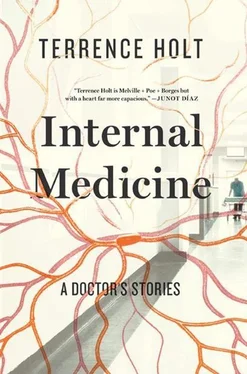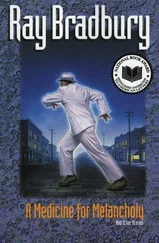THE NEXT MORNING ON ROUNDS, we were congratulated for our management of Mr. Gillet’s arrest, although there was an ominous pH value from a blood gas obtained early on in the event that occasioned some shaking of heads. He had not responded since the code, being content to lie there unconscious in his halo, his chest rising and falling in response to the ventilator’s efforts. But his vital signs were stable, his labs from the four a.m. draw were looking good, and I had my hopes. No longer for an early discharge, but I was hopeful, all the same.
I shared these hopes with Mrs. Gillet when she arrived at seven. She stood at the bedside looking down, and her eyes were wet, her mouth unstably mobile. She reached out almost to touch the bars supporting the halo, down one of the threaded rods that pierced her husband’s skin above the temple, almost touched there, then withdrew. “Is this the. thing? What do they call it?”
I was silent a moment.
“A halo,” I said finally. “They call it a halo.”
“Ah,” she said.
I left her at the bedside, Mrs. Gillet with one hand through the chrome that cradled her husband’s head.
DAVID GILLET DIED FIVE days later, having never regained consciousness. As each day passed and he gave no sign of mental activity, eventually it became clear that not all of him had survived the code. Mrs. Gillet decided, once pneumonia set in, to withdraw support. I had to agree. Even though I had anticipated the pneumonia, and was pretty sure I could get him through it, I had to agree it was for the best. Much as I wanted to keep him around.
He had become something unreal for me — something beautiful, like a work of art, but unreal. Amid all the mess and squalor of the hospital, with its blind random unraveling of lives, in their patient dignity and kindness he and his wife stood apart. In his case, for a little while at least, everything had gone exactly as it should have. The perfect code. And it hadn’t made any difference. No difference at all. I pulled his tube early in the afternoon, after a bedside service, and took my place at the wall while the usual drama worked to its conclusion.
She sent me a card that Christmas, Mrs. Gillet. I kept it for a while, until it vanished in the clutter on my desk. She had written a text inside, something from the New Testament I had admired at the bedside service, but soon forgot. I do remember vividly the picture on the card. It was like her: sober, attractive. It showed a medieval nativity scene, all saints and angels with their burnished golden ovals overhead. Their faces were sorrowful in profile, as if anticipating what will crown that rosy newborn, perfection laid in straw, with pain in time to come.
I WAS STILL IN THE PARKING GARAGE WHEN MY pager went off. The callback number was the ER. Naturally I was annoyed. This was week three of my first ICU rotation as a resident, and I was cranky with stress and lack of sleep, but even without that there was reason to be annoyed. The MAO is supposed to stall admissions between six and seven in the morning, out of courtesy to the team coming on call, which is busy getting ready to round. But the problem with critical care medicine is that some things can’t wait down in the ER while the rhythms of hospital life play out. So, annoyed but not surprised, I returned the page.
THE MAO, WHO HAD been up all night, was inexcusably cheery. “You’re gonna love this one,” he said.
“What?” I said flatly.
“Be that way. But you’re still gonna thank me.”
I grunted, having lost a parking space to an incoming medical student.
“Anyway, what we got here is a sixty-two-year-old lady with a big ICH, she’s—”
“Neurosurgery go home already?” I knew the futility of the question, but I had to make the attempt.
“Neurosurgery’s seen her and signed off. They said. ” I heard paper shuffle. “Here: ‘prognosis is dismal.’ They used the d -word. It’s a chip shot.”
I grunted noncommittally. I didn’t want to involve myself in the MAO’s creepy good cheer any more than I had to.
“She stable?”
“For now. Vented, obtunded, holding her pressures.”
“Family?”
“Family’s all here, I’ve talked to them, they seem reasonable, but I left the dirty work for you. You do it so well.”
I ignored him, grunting one more time as I finally wedged my car into a space vacated by a departing night nurse. “Don’t let the family get away.”
“Don’t worry. From the look of things, they’re here for the duration.”
IT WAS ALMOST TEN before I made my way toward the ER. In the meantime, in a none-too-surprising violation of custom, the ER had decided to send her up to the ICU before I’d had a chance to see her, so as the elevator opened I found myself facing a gurney bearing a large, unconscious form, a ventilator, a nurse, and a respiratory therapist. My doorway survey told me this patient wasn’t going to be on my service very long. I heard the echo of the MAO’s breezy chuckle and suppressed a grimace.
“This the lady with the head bleed?”
“You got it,” the nurse said, leaning hard to get the gurney into motion. It lurched out of the elevator, dragging the vent and IV pole behind it. I lent a hand, swiveling the assemblage out into the corridor.
“The family coming up?”
“They’re probably in your waiting room already.”
We got the patient into a room, settled a few questions about the vent, and I spent a minute rummaging through her chart, jotting down a name, age, and record number. There was a brown jacket with a CT from an outside hospital. I held it up to the fluorescents overhead. You didn’t need to be a neuroradiologist to call this one: there was an inky cloud larger than a golf ball low down on the right side of her brain. It was blood. It also marked a region of dead and dying brain cells, killed by pressure from the expanding mass. With a bleed like this, there’s essentially nothing to be done. There’s no avenue of approach for the surgeons that won’t destroy more than they could save. If the bleeding doesn’t stop, eventually the rising pressure in the skull will extrude the brain through a narrow opening in the membrane that supports the cerebrum within the skull. This process is called herniating: it’s inexorably fatal, but not all that common. From the looks of this one, she didn’t seem about to herniate. But it didn’t look like she was going to survive, either: the hole in her brain was big, and it was low, down where the essential circuitry of life is wired.
I WAS MARSHALING ALL of this largely automatically, as I moved from the smoky shadows of the CT to the patient herself, flashing light in her eyes, tapping on her joints, trying to elicit signs of withdrawal from pain. I wiggled the ventilator tube and she grimaced, slightly: the right side of her mouth curled back in a vague snarl. But the left side was motionless, slack, a slice of eye visible below the lid. With a last glance at the monitor, where a green light kept tracing a steady heartbeat, I made my way out to the waiting room.
AT THAT HOUR OF the day, the waiting room is usually empty, the TV set muttering to itself in a waste of polished blond wood and dusty fabric plants. This morning almost every chair was full. There were children sitting listlessly on the floor. Teenagers slumped in uncomfortable postures, small knots of couples and siblings and cousins and aunts and neighbors and friends and one frail-looking old man wearing a baseball cap with the name of a feed supplier on its stained green front.
“Are you the Wallace family?” I knew the answer, of course, but the sheer size of the crowd had me taken aback. I had a sense of things possibly escaping my control.
Читать дальше












